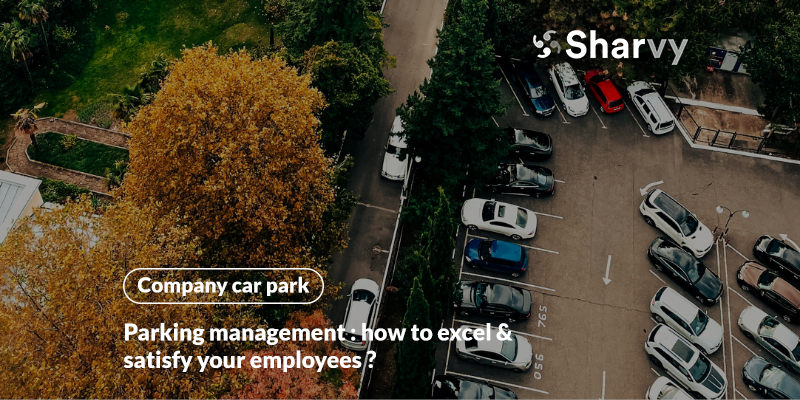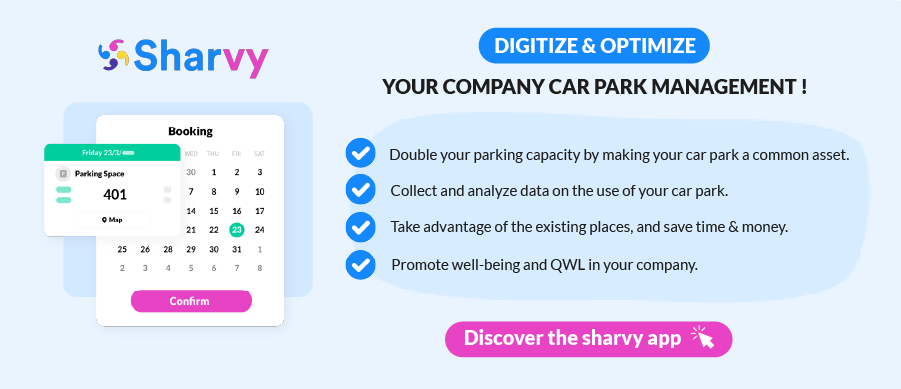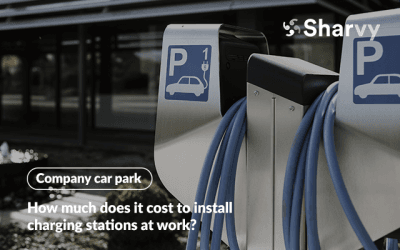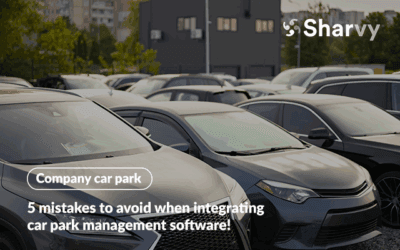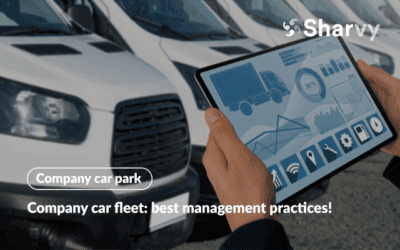Nowadays, the issues surrounding the management of company parking and its optimization are non-negligible. The reason is apparent : the rise of teleworking, with the new organizational modes taking hold, such as flex office and desk sharing, is turning company parking management upside down.
In essence, these practices reduce the need for employee parking. The result? On the one hand, companies are taking steps to optimize their real estate and are making savings. But on the other hand, they pay a high price for parking spaces, which often only are occupied if improvements are made.
However, the costs to businesses of poor management and fallow parking are substantial!
This is why implementing a real estate optimization approach goes hand in hand with optimizing the company car park. But how do you go about it? What measures should be taken to excel in managing your car park? How can it be improved to meet the high expectations of employees? All the answers are in this article.
What is “Parking Management” ? – Definition
To understand how to excel in parking management, one must first understand the term’s meaning. Parking management can be defined as a set of strategies to increase the efficiency of a parking facility’s supply.
Today, we are not telling you anything new by pointing out that parking is one of those irritants of everyday office life in many companies. It is often a thorny issue that only leads to frustration for employees.
This is why companies are increasingly looking at parking management solutions to improve their parking practices.
Especially since, by integrating digital technologies, the management possibilities are infinite! Companies can now devise rules for good use, systems for prioritizing and/or sharing spaces between users, rules for fairness, etc.
The aim is to transform the passive management of a company car park into intelligent and active management.
By considering this objective, companies can offer their employees and visitors a positive parking experience worthy of their vision! Moreover, as Sophie VOLLAND explains in a dedicated case study, they will also make immediate savings (up to 25% each year).
Parking management : what are the common practices of companies?
Due to population growth, traffic congestion in the city, and the new paradigms of the working world, companies should offer their employees, service providers, partners, and/or customers a parking solution.
However, more than offering access to the company car park to all or some of their employees is needed to improve their daily lives. The reason is apparent : only some companies have real and objective data on using their car park. This lack of statistics, combined with unsuccessful car park management, partly explains the saturation or, conversely, the under-utilization of the car park.
To better understand, here are some examples of current management practices :
1. A (total) lack of regulations in the car park
It is still common to find a need for parking regulations in some companies. This situation is regularly found in companies that have had more parking spaces than employees for years. As a result, there needs to be management and/or access control at the entrance. By default, access to the car park is based on the “First Come, First Served” principle. In other words, first come, first served.
However, this situation leads to many frustrations. Employees are forced to get up at the crack of dawn every morning, at the risk of not having a space in the car park. In the long run, this is stressful and can lead to internal conflicts and annoyance. At the same time, employees need visibility of the availability of parking spaces before they arrive on site.
2. Archaic parking management
In this case, the right of access to the car park is usually granted hierarchically, according to the employee’s seniority, hierarchical positions, company functions, etc.
These allocation methods could be more efficient and satisfactory for employees! The reason is apparent: this traditional policy of allocating a seat by name does not allow another employee to benefit from it. This is the case even if the place remains unoccupied throughout the day if the holder is absent. It is, therefore, a statutory preference that is becoming anachronistic given the new paradigms of the working world (flex desk, desk sharing, hot desking, etc.).
As teleworking is becoming widespread, with many employees working two days a week, this obviously contributes to increasing the vacancy of car parks, as well as the unpredictability of their use.
Finally, as Frédéric Veynachter, CTG HR Director for Luxembourg, points out :
“For employees, using car parks outside the company’s own is also uncomfortable. Even if the expenses are covered. After the morning traffic jams, this is a waste of time that they would like to avoid”.
As you can see, the archaic car park management also has its dark side. Not all employees have the chance to use the company car park.
3. Unilateral management of the company car park
This management policy usually results in more users than spaces. Consequently, in this case, the car park manager is the sole decision-maker on access rights to the car park. Therefore, he tries to satisfy as many users as possible, taking into account the particularities of each one.
For many employees, using a car is unavoidable because of the distance between home and work, a house with poor public transport links, children to be taken to and from work or medical constraints, etc.
However, for the car park manager, it can be difficult to enforce the framework. They need more control over the use and the car park occupation. All the more so if access control to the car park is tedious, as can be the case with RFID readers and badges. In particular, because of the many losses, thefts, breakages, exchanges, and lack of flexibility that this entails.
In addition, this type of access control, which is still common in companies, does not facilitate multi-site car park management. Not only are practices not harmonized, but the cost of implementation, maintenance, and control are restrictive for the car park manager.
Finally, although this management considers (more or less) the singularities of each person and tries to satisfy a maximum of employees, decisions on access rights to the car park remain unilateral. As a result, equity in access to the car park is only sometimes satisfied, and these management policies are also challenging to maintain over time.
What are the best practices for optimal company car park management?
To excel in your company parking policy and to satisfy your employees, it is essential to let your employees control the use of the car park while respecting your company’s parking policy.
However, it is evident that for typical companies – SMEs, ETIs, GEs – the needs of all employees will still need to be met. This is why it is interesting for them to digitize their practices and use a SaaS solution to manage the company car park, like Sharvy.
This allows the car park manager to configure priority and usage rules so that users can freely reserve and release their space via a dedicated application and/or an online interface.
From then on, in real-time and on their smartphone, employees can check availability in the car park, reserve a space, access it without any problem thanks to a dynamic map, free their assigned space when they are absent, or report an incident in the car park.
This type of solution thus offers 3 major parking policies, namely :
1. Forward planning
In this case, you offer your employees the possibility to reserve a parking space before their arrival. For example, by offering them a vision on the availability or unavailability of parking spaces, so that they can anticipate and choose their means of transportation accordingly. This management can also include real-time notifications, allowing users to be immediately informed of availabilities, thus reducing the stress associated with searching for a spot.
2. Flexible management
Here, you can reallocate the space of absent staff to make them available for reservation by other employees. This way, you reduce the complaints and/or frustrations of all or part of the employees who have less regular access to the car park. It is therefore a more flexible management than forecast management. This flexibility is enhanced by a management system that ensures an equitable distribution of available spaces, with automatic updates and options to customize the allocation criteria, such as usage frequency or duration of absences.
3. Dynamic & fair management
In this case, you combine the above management. In other words, your employees anticipate their presence at the company, and plan if they need parking. If an employee has a space and plans to be out of the office, he/she will responsibly & independently release the space and return it to the “common pot”. Conversely, if the employee is requesting a spot, he/she will make a request (via a dedicated application, such as Sharvy) and get a spot based on a fair algorithm. Such a policy aims to allow users to consume according to their needs within a predefined framework.
Note that the Sharvy solution supports you in these matters!
In November 2024, out of all our users : 96.3% obtained a parking space. 12.5% have named seats, and 1/3 of the time, users who have an assigned seat share it with other users.
It is worth noting that it is entirely possible to combine fairness and efficiency. Managing a company car park is not just a question of logistics: it also raises the issue of fairness. While some companies choose to allocate the best spaces to managers or senior staff, this practice can quickly be perceived as unfair by other employees.
Conversely, a completely free system can create daily competition and frustration. The key lies in striking a balance: defining transparent rules based on objective criteria (such as distance between home and work, staggered working hours, reduced mobility, and carpooling) and communicating them clearly. By combining these rules with digital booking tools such as Sharvy, the company can both optimise parking efficiency and reinforce a sense of organisational fairness, which has a direct impact on team satisfaction.
How to go about it? 6 actions to take to excel in your parking management!
1. Carry out an audit of the existing : list the strengths and areas for improve your car park.
This is not surprising, but it should be remembered that this first step is the obvious starting point for gaining insight into your car park’s capabilities, strengths, and areas for improvement.
It is, therefore, a good idea to take stock of the current segmentation of your car park :
- To date, does your company car park promote multimodal mobility?
- Do you have secure bicycle parking spaces or, more generally, for NVEI?
- Does access and security to the car park need to be improved?
- Is access to the car park for visitors possible? Is it smooth and unobtrusive?
- Is the multi-site car park management facilitated?
- Do you have free but unused space? Etc.
The list of essential questions to ask yourself is still long! So, to help you evaluate your car park and the possibilities it offers you, download our free e-book and find out the key points to optimize your company car park.
2. Distinguish between direct and indirect costs in order to take advantage of the existing.
To know and better understand the costs allocated to managing your company car park, it is essential to distinguish between direct and indirect costs.
- Direct (visible) costs : here, we distinguish between the prices of rented parking spaces and the costs of the parking spaces as a proportion of your office rental. For example, in major cities in UK, such as Londres, Liverpool or Birmingham, a parking space costs between $1,500 and $2,000 per year.
- Indirect (hidden) costs : More challenging to quantify, these costs depend (somewhat) on the overall management of your company’s car park. For example, an employee in Birmingham loses up to 30 minutes a day looking for a parking space, according to an INRIX study. Over a week, this represents up to 2.5 hours of lost time that the employee could have used to be productive for the company. To do this, you also need to quantify the lost revenue due to an employee’s daily stress and frustration due to a negative parking experience.
Therefore, on this second point, the objective is to take advantage of what already exists, while identifying the potential savings to be made!
3. Identify the actions that meet the needs and expectations of your employees.
Once the first two steps have been taken, it is essential to orientate your parking management strategy (in the right direction).
All the more so since today, due to the stress suffered by city dwellers as a result of transport, it is wise to start by focusing on everything that will make your employees’ journeys more fluid and comfortable. This will be another step towards their satisfaction. Moreover, acting on the mobility practices of your employees is an essential lever for serving QWL, CSR, and the achievement of sustainable mobility, and/ or electric mobility as well as the employer brand.
To achieve this, it is best to survey your employees. So, prepare a schedule for distributing and collecting the questionnaire. At the same time, accompany the distribution of the questionnaire with internal communication.
To help you, here is a list of facilities that employees often request :
- A closed and secure shelter for parking two-wheelers (bicycles, motorbikes, NVEI, etc).
- Lockers to leave personal belongings in a safe place.
- Charging points for electric and rechargeable hybrid vehicles.
- PRM places in compliance with standards, with an accessible path, without danger or obstacles!
- A fluid access control system at the entrance to the company car park…
This list is incomplete! In addition, keep in mind that the problems encountered by companies are specific to each one, so the parking policy and the resulting actions must be explicitly created to meet the needs of YOUR employees.
4. Target the measures that will form the pillars of your parking policy.
Today, it is evident that without a well-thought-out and intuitive parking management strategy, one hand, employees will constantly raise complaints and/or frustrations about parking. On the other hand, on the company side, the costs that can arise from poor management will be substantial!
That is why it is essential to integrate various measures into your parking policy. For example, you can imagine :
- Incentive measures : encourage (more) rational car use by your employees. For example, encourage them to carpool by guaranteeing a space in the company car park. Also, promote less polluting modes of transport by contributing financially to your employees’ public transport subscriptions (metro, bus, tramway, etc). Finally, install appropriate facilities to encourage cycling… These measures aim to promote intermodality and multimodality in your company car park.
- Preferential measures : employees with this access will be allocated a space in the car park. For example, you can offer privileged access to people with reduced mobility (PRM), carpoolers, and employees with no other valid alternative (distance to work, medical constraints, children, etc). Consequently, these parking management measures aim to improve the distribution and allocation of parking spaces according to specific criteria.
- Penalising measures : these depend on the company’s culture and are only suitable for some companies. Although they are often misunderstood, they are effective. For example, you can establish a clear system of sanctions and take steps to investigate all those who violate the rules of your parking policy and company procedures. For example, sanctions can be issued (e.g, a 10-day parking ban) to people who make a parking reservation and then fail to show up on the day in question.
5. Ensure seamless access control & security of your car park.
Without an access control system for the car park, it can be tempting for people outside the company to enter and occupy the spaces reserved for employees. Unfortunately, this does not prevent them from vandalizing or stealing vehicles and/or equipment in the car park.
This is why securing access to your company car park is essential. To do this, having a gate, a security barrier, and/or a retractable access control terminal is an first point.
However, in addition to this installation, you can consider a human presence, a camera with license plate recognition, an IoT module linked to a dedicated mobile application, such as Sharvy, and/or RFID readers & badges.
6. Continuously measure, adjust and innovate.
For effective parking management, regular performance monitoring is essential. Analyse occupancy rates and gather employee feedback to assess satisfaction and the effectiveness of initiatives. This data can be used to identify areas for improvement and adjust spaces or tools accordingly.
Adapt to change: redesign car parks to include dedicated areas (electric vehicles, car-sharing) and incorporate modern technologies such as sensors or automated systems.
Finally, anticipate trends by exploring connected car parks or AI-based solutions for predicting peak use. Agile & innovative management guarantees long-term employee satisfaction! Keep this in mind.
In conclusion
For many years, companies have not been interested in managing their car parks. This resource used to be abundant and cheap! But today, this is not the case anymore. It is becoming impossible for companies to provide a dedicated space for each employee.
This is why parking management strategies make sense. Companies are increasingly aware of the added value of good parking management – both for their employees and visitors – and the financial windfall beneath their feet.
As a result, they can continue taking proactive measures to optimize the management of their company car park and the occupancy rate. And at the same time, they save money, improve well-being at work and offer a positive parking experience to their employees!
Have a question? Check the following FAQ!
How does Parking Management help you to improve your CSR approach?
It is important to remember that, as a company, you directly impact the mobility of your employees. Therefore, you encourage rotation in parking spaces by giving all or some of your employee’s access to the company car park via a well-thought-out and fair “Parking Management” strategy. This will make the holder more willing to use public transport and/or favor soft mobility (carpooling, cycling, electric scooters, and NEVs). And this without losing the use of the parking space, which encourages multimodality.
Thus, by rethinking the uses of your company car park, in particular by reconciling the obligation to free up space with the parking needs of a user, you are improving your CSR approach and encouraging the use of more sustainable mobility.
What are the benefits of a well thought-out and fair parking management policy?
The main advantages include the fact that the company can offer more parking space. Finding a parking space is time-consuming, stressful, and burdensome for many. This way, you improve their quality of life at work sustainably.
At the same time, you offer them the opportunity to plan their mobility. If they cannot obtain/reserve a parking space before coming on-site, they can use public transport or a two-wheeler (bicycle, NVEI, etc). They don’t have to waste time looking for a parking space close to the workplace; they can also respect their schedule and don’t have to start the day with a bad feeling!
Finally, using a parking management solution like Sharvy allows you to share your parking spaces effectively and fairly without you having to lift a finger! By digitizing your practices, you get a global and real-time view of the occupation and use of your car park while collecting various data to make the right management decisions. In addition, solutions like Sharvy also allow you to activate and deactivate access rights to your car park in a few clicks. This is according to your needs (departure from the company, change of function, recruitment wave, etc).
Not to mention that you optimize the overall management of your car park and make immediate savings of up to 25% of the amount allocated to this budget.
How can a company implement a Parking Management solution?
The first step is to conduct a thorough analysis of the company’s specific parking management needs. This phase involves understanding the current parking models, traffic volumes, and operational requirements.
Based on the findings from the needs analysis, the Parking Management solution is customised to meet the company’s specific needs. This may include functional adjustments, specific configurations, and bespoke integrations. This is what we do at Sharvy.
Finally, a detailed deployment plan is developed in collaboration with internal stakeholders. This plan includes resource allocation, the definition of deployment stages, and the creation of a realistic timeline to minimise operational disruptions. At the same time, interactive training sessions, user guides, and educational materials may be provided to ensure effective adoption.
Want to learn more? Check out our latest articles!
How much does it cost to install charging stations at work?
What is the real cost of installing charging stations in a business? How can you optimise your investment? Here are the answers!
5 mistakes to avoid when integrating car park management software!
What are the 5 most common mistakes to avoid before and during the integration of parking management software? Focus!
Company car fleet: best management practices!
Should you electrify, pool or automate your company car fleet? What are the best management practices? Let’s take a closer look!
Subscribe to our newsletter!
PARKING & WORKPLACE MANAGEMENT SOLUTION
Car park management - Charging points monitoring - Desk booking - Booking by time slots
SUBSCRIBE TO THE NEWSLETTER
Receive the latest Parking & Workplace trends by email once a month.

